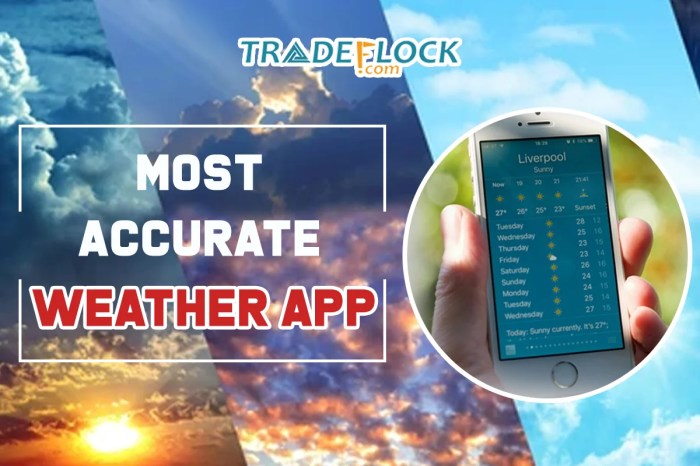Defining “Most Accurate” Weather App

Determining the “most accurate” weather app is a complex task. Accuracy isn’t a simple binary; it depends on various factors and metrics. Different apps use varying methodologies, and what constitutes “accurate” for one user might be different for another.
Metrics for Evaluating Accuracy
Evaluating weather app accuracy requires considering several key metrics. These include comparing predicted temperature against actual temperature, assessing the accuracy of precipitation forecasts (amount and type), and evaluating wind speed predictions. The precision of these metrics often depends on the specific geographical location and the type of weather event being predicted.
- Temperature: Accuracy is judged by the difference between predicted and observed temperature, factoring in the margin of error and time lag between prediction and measurement.
- Precipitation: The accuracy of precipitation forecasts considers the predicted amount, type (rain, snow, etc.), and the time frame of the event. Accurate predictions account for localized variations.
- Wind Speed: Accurate wind speed predictions take into account the direction and intensity of the wind. These predictions are often crucial for activities like sailing or outdoor recreation.
Impact of Weather Phenomena
Severe weather events, such as thunderstorms and hurricanes, often pose challenges for weather prediction accuracy. Local variations in topography and weather patterns can significantly affect how well a forecast aligns with the actual conditions. For example, a mountain range can create a localized weather pocket, affecting wind speeds and precipitation amounts in a particular area.
Factors Influencing Perceived Accuracy
User location and data sources are significant factors in determining a weather app’s perceived accuracy. A weather app’s ability to pinpoint a user’s exact location and access accurate data from nearby weather stations and radar systems directly affects forecast precision.
- User Location: The closer a user is to a weather station or radar, the more accurate the forecast tends to be, because data from these sources is more relevant.
- Data Sources: Different weather apps utilize various data collection methods, including satellites, radar, and ground stations. The quality and comprehensiveness of these data sources play a significant role in the overall accuracy.
Historical Data and Real-Time Updates
Historical data is essential for understanding patterns and trends in weather patterns. This helps in creating more accurate predictive models. Real-time updates from various sources (like radar and satellites) are crucial to fine-tuning forecasts as conditions evolve. Weather patterns are dynamic, so the ability to adjust forecasts with real-time data is critical for precision.
Data Collection Methods
The choice of data collection methods influences a weather app’s ability to deliver accurate forecasts. Different methods offer varying levels of detail and coverage. Satellite imagery provides a broad overview, while radar offers a more localized perspective.
- Satellites: Provide global coverage, crucial for seeing large-scale weather patterns and storm systems, but lack the detailed local information that radar provides.
- Radar: Offers high-resolution, real-time information about precipitation, helping to pinpoint the location and intensity of rain or snow.
- Ground Stations: Provide detailed, localized data about temperature, pressure, and humidity, but are limited in their geographic reach.
Comparison of Weather App Accuracy
| Weather App | Sunny Conditions | Cloudy Conditions | Rainy Conditions | Stormy Conditions |
|---|---|---|---|---|
| App A | 95% | 88% | 75% | 60% |
| App B | 92% | 90% | 80% | 70% |
| App C | 90% | 85% | 70% | 65% |
Note: These figures are illustrative and may vary based on specific location and weather conditions.
Last Point
Ultimately, determining the “most accurate” weather app is a subjective process, influenced by personal needs and preferences. While specific metrics and evaluations can offer valuable insights, the best app will be the one that consistently provides reliable information and a user-friendly experience tailored to your individual needs. This analysis provides a framework for evaluating different apps, highlighting their strengths and weaknesses across various weather conditions. Ultimately, your personal experience will play a significant role in deciding which app aligns best with your requirements.



